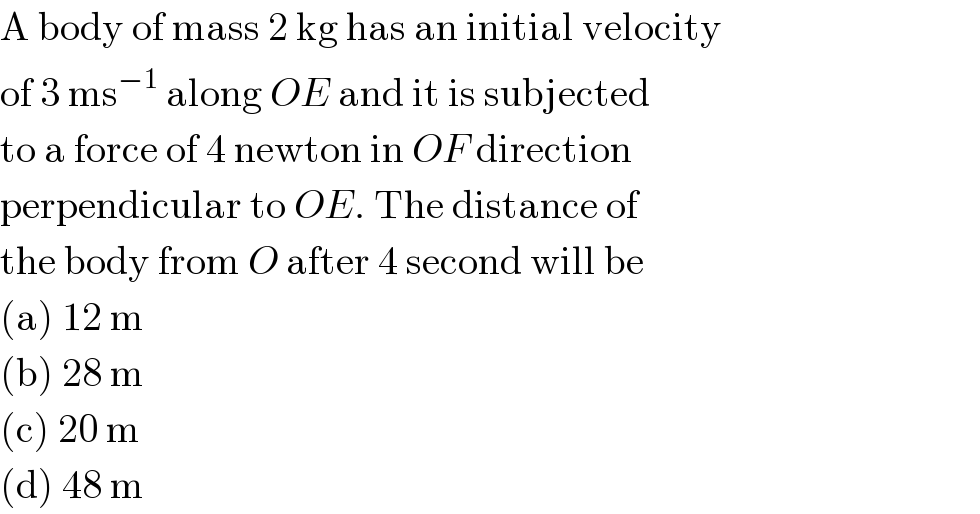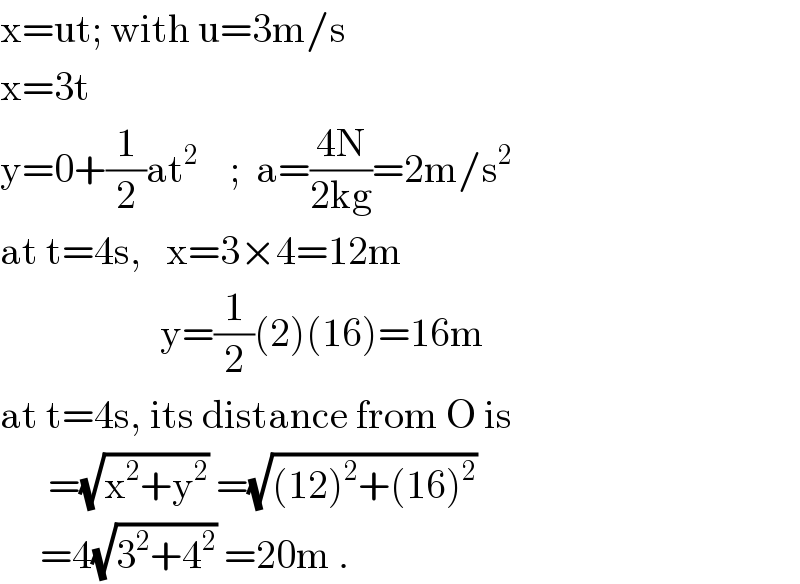
Question Number 13510 by Tinkutara last updated on 20/May/17

$$\mathrm{A}\:\mathrm{body}\:\mathrm{of}\:\mathrm{mass}\:\mathrm{2}\:\mathrm{kg}\:\mathrm{has}\:\mathrm{an}\:\mathrm{initial}\:\mathrm{velocity} \\ $$$$\mathrm{of}\:\mathrm{3}\:\mathrm{ms}^{−\mathrm{1}} \:\mathrm{along}\:{OE}\:\mathrm{and}\:\mathrm{it}\:\mathrm{is}\:\mathrm{subjected} \\ $$$$\mathrm{to}\:\mathrm{a}\:\mathrm{force}\:\mathrm{of}\:\mathrm{4}\:\mathrm{newton}\:\mathrm{in}\:{OF}\:\mathrm{direction} \\ $$$$\mathrm{perpendicular}\:\mathrm{to}\:{OE}.\:\mathrm{The}\:\mathrm{distance}\:\mathrm{of} \\ $$$$\mathrm{the}\:\mathrm{body}\:\mathrm{from}\:{O}\:\mathrm{after}\:\mathrm{4}\:\mathrm{second}\:\mathrm{will}\:\mathrm{be} \\ $$$$\left(\mathrm{a}\right)\:\mathrm{12}\:\mathrm{m} \\ $$$$\left(\mathrm{b}\right)\:\mathrm{28}\:\mathrm{m} \\ $$$$\left(\mathrm{c}\right)\:\mathrm{20}\:\mathrm{m} \\ $$$$\left(\mathrm{d}\right)\:\mathrm{48}\:\mathrm{m} \\ $$
Commented by ajfour last updated on 20/May/17

Answered by ajfour last updated on 20/May/17

$$\mathrm{x}=\mathrm{ut};\:\mathrm{with}\:\mathrm{u}=\mathrm{3m}/\mathrm{s} \\ $$$$\mathrm{x}=\mathrm{3t} \\ $$$$\mathrm{y}=\mathrm{0}+\frac{\mathrm{1}}{\mathrm{2}}\mathrm{at}^{\mathrm{2}} \:\:\:\:;\:\:\mathrm{a}=\frac{\mathrm{4N}}{\mathrm{2kg}}=\mathrm{2m}/\mathrm{s}^{\mathrm{2}} \\ $$$$\mathrm{at}\:\mathrm{t}=\mathrm{4s},\:\:\:\mathrm{x}=\mathrm{3}×\mathrm{4}=\mathrm{12m} \\ $$$$\:\:\:\:\:\:\:\:\:\:\:\:\:\:\:\:\:\:\:\:\mathrm{y}=\frac{\mathrm{1}}{\mathrm{2}}\left(\mathrm{2}\right)\left(\mathrm{16}\right)=\mathrm{16m} \\ $$$$\mathrm{at}\:\mathrm{t}=\mathrm{4s},\:\mathrm{its}\:\mathrm{distance}\:\mathrm{from}\:\mathrm{O}\:\mathrm{is} \\ $$$$\:\:\:\:\:\:=\sqrt{\mathrm{x}^{\mathrm{2}} +\mathrm{y}^{\mathrm{2}} }\:=\sqrt{\left(\mathrm{12}\right)^{\mathrm{2}} +\left(\mathrm{16}\right)^{\mathrm{2}} }\: \\ $$$$\:\:\:\:\:=\mathrm{4}\sqrt{\mathrm{3}^{\mathrm{2}} +\mathrm{4}^{\mathrm{2}} }\:=\mathrm{20m}\:. \\ $$
Commented by Tinkutara last updated on 20/May/17

$$\mathrm{Thanks}\:\mathrm{Sir}! \\ $$
